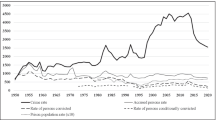Abstract
Over the last two decades, the Spanish social fabric has undergone a variety of profound changes, which in turn may explain the rise in police-recorded crime and prison population figures. Although the rise in crime reported to the police has been higher for common offences—misdemeanors—, the mainstream media concentrates overwhelmingly in serious violent crimes—felonies—. Spain does not have an official agency responsible for conducting victimization surveys to measure crime trends as directly experienced by the citizens. Based on this methodology, our study shows that contrary to information gathered from police data, and despite social fabric changes, crime in Spain is decreasing. The present study also reveals the distorted public perception of this trend, which seems to respond to a repetitive coverage of serious crime by the mainstream media.


























Similar content being viewed by others
Notes
The Household Survey on Alcohol and Drug Use (Encuesta domiciliaria sobre alcohol y drogas en España or EDADES), conducted in 2005. And the State Survey on Drug Use in Secondary Schools (Encuesta estatal sobre uso de drogas en enseñanzas secundarias or ESTUDES), conducted in 2006.
References
Barberet, R. (2005). Spain. European Journal of Criminology. http://euc.sagepub.com/cgi/content/abstract/2/3/341.
Bericat, E. (2006). El cambio social en España. Centro de Estudios Andaluces.
Boletín Informativo Del Instituto Nacional De Estadística (INE) 2/2004. 15 de mayo. Día internacional de las familias.
Boletín Informativo Del Instituto Nacional De Estadística (INE) 3/2009. 15 de mayo. Día internacional de las familias.
Casares, E. (2008). Estudio sobre el cambio de estructura de las relaciones familiares. Portuaria, VIII(nº 1).
Cid Moline, J. (2008). El incremento de la población reclusa en España entre 1996 y 2006: Diagnóstico y remedios. Revista Española de Investigación Criminológica, núm. 6. http://www.criminologia.net/reic.html.
Comas, D. (1995). Explorando el papel sociocultural de las drogas en los años 90: conclusiones de una investigación. Cuadernos de Cuadernos de Trabajo Social, n. 8.
Díez-Ripollés, J. L. (1996). Delincuencia y víctimas. Valencia: Tirant lo Blanch.
Díez-Ripollés, J.L. (2006). Algunos rasgos de la delincuencia en España a comienzos del siglo XXI. en Revista Española de Investigación Criminológica, núm. 4. http://www.criminologia.net/reic.html.
Díez-Ripollés, J.L. (2007). La política criminal en la encrucijada. BdeF.
Díez-Ripollés, J.L., & García España, E. (dirs) (2009). Encuestas a víctimas en España. IAIC-Fundación Cajasol.
Díez-Ripollés, J.L., & Giménez-Salinas, A. (2010). Opacidad en las cifras del crimen. http://blogs.publico.es/otrasmiradas/19/opacidad-en-las-cifras-del-crimen/.
EDIS. (1998). “O consumo de drogas en Galicia” IV Colección Drogodependencias no 21. Santiago de Compostela: Consellería de Sanidade e Servicios Sociais.
Fundación FOESSA. (2008). VI Informe sobre exclusión y desarrollo social en España 2008. Madrid: Fundación FOESSA.
Fundación INCYDE. (2007). Mujeres empresarias en la economía española. Madrid: Cámaras de Comercio.
García-España, E., & Pérez Jiménez, F. (2004). Reciente evolución de la delincuencia en Andalucía. en Revista Electrónica de Ciencia penal y Criminología. 06-04. http://criminet.ugr.es/recpc/.
García-España, E. (2005). Evolución de los hechos conocidos, detenciones y población penitenciaria. Revista de Derecho penal y Criminología, nº 16.
García-España, E., Pérez Jiménez, F., & Benítez Jiménez, M.J. (2006). La delincuencia según las víctimas: un enfoque integrado a partir de una encuesta de victimización. Edit. Fundación el Monte y el IAIC. Málaga. http://www.uma.es/criminologia/oda/2006.pdf.
García-España, E., Pérez Jiménez, F., & Benítez Jiménez, M.J. (2007). La delincuencia en Córdoba, Huelva y Sevilla. Una encuesta de victimización. Edit. Cajasol Obra Social y el IAIC. Málaga. http://www.uma.es/criminologia/oda/2007.pdf.
García-España, E., Pérez Jiménez, F., & Benítez Jiménez, M.J. (2008). La delincuencia en las capitales andaluzas. Encuestas de victimización en Andalucía. IAIC-Fundación Cajasol. http://www.uma.es/criminologia/oda/2008.pdf.
García Pérez, O. (2008). “La reforma de 2006 del sistema español de justicia penal de menores” en Revista Electrónica Semestral de Políticas Públicas en Materias Penales, núm. 5. http://www.politicacriminal.cl/n_05/A_1_5.pdf.
Griffin, K.W., Botvin, G.J., Scheier, L.M., Diaz, T., & Miller, N.L. (2000). Parenting practices as predictors of substance use, delinquency, and aggression among urban minority youth: Moderating effects of family structure and gender. Psychology of Addictive Behaviors, 14(2).
Harden, K.P., D’onofrio, B.M., Van Hulle, C., Turkheimer, E., Rodgers, J.L., & Waldman, I.D. et al. (2009). Population Density and Youth Antisocial Behavior. Journal of child psychology and psychiatry, 50(8).
Hidalgo Vega, A., Pérez Camarero, S., & Calderon Milán, M.J. La discriminación laboral de la mujer: una década a examen. Disponible en http://www.inmujer.migualdad.es/MUJER/mujeres/estud_inves/estud_anterior08.html. Date of consultation: March 2010.
INE (1995). Panorámica social de España. Madrid.
Kierkus, C.A., & Hewitt, J.D. (2005). Family Structure and Delinquency: Does Context Matter? Paper presented at the annual meeting of the American Society of Criminology, Royal York, Toronto.
Matsueda, R.L., & Heimer, K. (1987). Race, family structure, and delinquency: a test of differential association and social control theories. American Sociological Review, 52(6).
Muñoz Sánchez (dir) (2004). Las drogas en la delincuencia. Tirant lo Blanch.
Nuñez Pérez, A., Soto Carballada, C., & Castro Pastor, A. (1998). Consumo de drogas en España: Reflexiones sobre sus tendencias epidemiológicas y sociales. Psiquiatría Pública, 10(8).
Rand, M.R. (2009). Criminal victimization, 2008. National Crime Victimization Survey. Bureau of Justice Statistics Bulletin. U.S. Department of Justice. September.
Van Dijk, J., Van Kesteren, J., & Smit, P. (2007). Criminal victimisation in international perspective, 2004–2005. Edit. WODC.
Author information
Authors and Affiliations
Corresponding author
Additional information
This study has been conducted within the framework of the Project PUBLIC SECURITY AS AN INSPIRATIONAL CRITERIA FOR CRIMINAL INTERVENTION [LA SEGURIDAD CIUDADANA COMO CRITERIO INSPIRADOR DE LA INTERVENCIÓN PENAL] (SEJ2006-07242/JURI), financed by the National Program for Scientific Research, Development and Technological Innovation at the State Secretariat of Universities and Research from the Ministry of Education and Science.
Rights and permissions
About this article
Cite this article
Garcia-España, E., Diez-Ripolles, J.L., Perez, F. et al. Crime trends through two decades of social changes in Spain. Crime Law Soc Change 54, 359–380 (2010). https://doi.org/10.1007/s10611-010-9262-5
Published:
Issue Date:
DOI: https://doi.org/10.1007/s10611-010-9262-5




